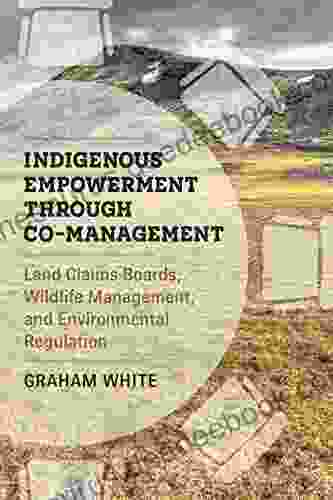Land Claims Boards, Wildlife Management, and Environmental Regulation: A Comprehensive Guide

Land claims, wildlife management, and environmental regulation are interconnected issues that play a crucial role in shaping our relationship with the natural world. This article aims to provide a comprehensive overview of these topics, exploring their historical context, legal frameworks, and contemporary challenges. By understanding these concepts, we can better appreciate the complexities of land use and resource management and become more informed participants in the decision-making processes that affect our environment.
5 out of 5
| Language | : | English |
| File size | : | 2727 KB |
| Text-to-Speech | : | Enabled |
| Screen Reader | : | Supported |
| Enhanced typesetting | : | Enabled |
| Word Wise | : | Enabled |
| Print length | : | 399 pages |
| Lending | : | Enabled |
| Paperback | : | 90 pages |
| Item Weight | : | 0.704 ounces |
| Dimensions | : | 5.91 x 0.21 x 8.27 inches |
Land Claims Boards
Land claims boards are quasi-judicial bodies established to adjudicate disputes over land ownership and use, particularly in cases involving Indigenous or First Nations communities. These boards are mandated to address historical grievances and ensure fair access to land and resources for Indigenous peoples.
Functions and Processes
Land claims boards typically perform the following functions:
- Investigate and adjudicate land claims
- Determine the validity of Indigenous title and rights
- Negotiate and settle agreements between Indigenous communities and governments
- Monitor compliance with land claim agreements
The processes involved in land claim adjudication vary depending on the specific board and jurisdiction. Generally, the process includes:
- Submission of a land claim by an Indigenous community
- Investigation and research by the board
- Public hearings and evidence gathering
- Issuance of a decision and recommendation by the board
- Negotiation and settlement of an agreement between the parties
Significance
Land claims boards play a vital role in addressing historical injustices and promoting reconciliation between Indigenous communities and governments. They provide a forum for Indigenous peoples to assert their rights and seek redress for past wrongs. By recognizing Indigenous title and rights, land claims boards contribute to the preservation of Indigenous cultures and the protection of traditional lands and resources.
Wildlife Management
Wildlife management encompasses the scientific and practical techniques used to manage wildlife populations and their habitats. It aims to ensure the long-term survival and sustainability of wildlife species while considering human needs and values.
Goals and Objectives
The primary goals of wildlife management include:
- Maintaining healthy and viable wildlife populations
- Preserving biological diversity
- Providing recreational opportunities
- Mitigating human-wildlife conflicts
- Protecting threatened and endangered species
Methods and Techniques
Wildlife managers employ various methods and techniques to achieve their objectives, including:
- Habitat management (e.g., creating or restoring wildlife habitats)
- Population monitoring (e.g., conducting surveys and data analysis)
- Harvest management (e.g., setting hunting quotas and regulations)
- Translocation and re (e.g., moving animals to new or former habitats)
- Research and education
Significance
Wildlife management is essential for ensuring the health of our ecosystems and the well-being of wildlife species. By managing wildlife populations, we can prevent overpopulation, protect endangered species, and mitigate human-wildlife conflicts. Wildlife management also provides recreational opportunities and economic benefits through hunting, fishing, and tourism.
Environmental Regulation
Environmental regulation refers to laws, policies, and regulations designed to protect the environment from pollution and degradation. It aims to minimize the negative impacts of human activities on the natural world and ensure the health and well-being of both humans and ecosystems.
Legal Frameworks
Environmental regulation is typically established through various legal frameworks, including:
- Statutory laws (e.g., the Clean Water Act, the Endangered Species Act)
- Administrative regulations (e.g., regulations issued by environmental agencies)
- International treaties (e.g., the Paris Agreement on climate change)
These frameworks define the scope and authority of environmental regulation, establish standards for environmental protection, and provide mechanisms for enforcement.
Types of Regulation
Environmental regulation encompasses a wide range of measures, including:
- Emission standards: Limits on the amount of pollutants that can be released into the environment
- Water quality standards: Limits on the levels of pollutants that can be present in water bodies
- Land use regulations: Controls on the development and use of land to protect sensitive ecosystems
- Environmental impact assessments: Assessments of the potential environmental impacts of proposed projects
- Enforcement and compliance: Mechanisms to ensure compliance with environmental regulations
Significance
Environmental regulation plays a crucial role in protecting human health and the environment. It helps reduce air and water pollution, mitigate climate change, conserve natural resources, and protect biodiversity. By regulating human activities, environmental regulation ensures a cleaner, healthier, and more sustainable future for generations to come.
Interconnections and Challenges
Land claims, wildlife management, and environmental regulation are interconnected issues that intersect in complex ways. For example, the recognition of Indigenous land rights can have implications for wildlife management and the establishment of protected areas. Similarly, environmental regulations can impact wildlife populations and their habitats. It is essential to consider these interconnections and adopt a holistic approach to land use and resource management.
Some of the challenges in this field include:
- Balancing competing interests between Indigenous communities, wildlife managers, and environmental regulators
- Addressing the effects of climate change on wildlife populations and ecosystems
- Enforcing environmental regulations and ensuring compliance
- Promoting collaboration and cooperation between various stakeholders
Land claims boards, wildlife management, and environmental regulation are essential components of a sustainable and just society. By understanding these concepts, we can make informed decisions about how we use and protect our natural resources. As we navigate the challenges of the 21st century, it is imperative that we work together to ensure a future where the rights of Indigenous peoples are respected, wildlife populations thrive, and the environment is protected for generations to come.
5 out of 5
| Language | : | English |
| File size | : | 2727 KB |
| Text-to-Speech | : | Enabled |
| Screen Reader | : | Supported |
| Enhanced typesetting | : | Enabled |
| Word Wise | : | Enabled |
| Print length | : | 399 pages |
| Lending | : | Enabled |
| Paperback | : | 90 pages |
| Item Weight | : | 0.704 ounces |
| Dimensions | : | 5.91 x 0.21 x 8.27 inches |
Do you want to contribute by writing guest posts on this blog?
Please contact us and send us a resume of previous articles that you have written.
 Novel
Novel Page
Page Chapter
Chapter Story
Story Genre
Genre Reader
Reader E-book
E-book Magazine
Magazine Paragraph
Paragraph Bookmark
Bookmark Glossary
Glossary Bibliography
Bibliography Preface
Preface Synopsis
Synopsis Annotation
Annotation Manuscript
Manuscript Scroll
Scroll Library card
Library card Narrative
Narrative Autobiography
Autobiography Dictionary
Dictionary Thesaurus
Thesaurus Narrator
Narrator Resolution
Resolution Librarian
Librarian Catalog
Catalog Card Catalog
Card Catalog Stacks
Stacks Study
Study Research
Research Scholarly
Scholarly Rare Books
Rare Books Special Collections
Special Collections Interlibrary
Interlibrary Study Group
Study Group Dissertation
Dissertation Storytelling
Storytelling Awards
Awards Book Club
Book Club Textbooks
Textbooks William Potter
William Potter Kristen Kelley
Kristen Kelley Timothy Gordon
Timothy Gordon Earl Rogers
Earl Rogers Alison Weir
Alison Weir Antonia Chen
Antonia Chen Ylvis
Ylvis Brandon D Lundy
Brandon D Lundy Jack Turk
Jack Turk Fish Davis
Fish Davis Charles Battell Loomis
Charles Battell Loomis Celia Vergon
Celia Vergon Chaconia J Agyenkwah
Chaconia J Agyenkwah Marie Sontag
Marie Sontag Timothy Stephany
Timothy Stephany Monroe A Majors
Monroe A Majors Alex T Smith
Alex T Smith Michael Moynihan
Michael Moynihan Hooshang Bolooki
Hooshang Bolooki Tom Cheetham
Tom Cheetham
Light bulbAdvertise smarter! Our strategic ad space ensures maximum exposure. Reserve your spot today!

 Virginia WoolfEssays On Race Gender And The Postmodern South Music Of The American South...
Virginia WoolfEssays On Race Gender And The Postmodern South Music Of The American South...
 Tyler NelsonUnveiling the Secrets of Joseph Loughlin's Pulse-Pounding Thriller: A Journey...
Tyler NelsonUnveiling the Secrets of Joseph Loughlin's Pulse-Pounding Thriller: A Journey... Peter CarterFollow ·5k
Peter CarterFollow ·5k Avery SimmonsFollow ·3.2k
Avery SimmonsFollow ·3.2k Mario Vargas LlosaFollow ·3.6k
Mario Vargas LlosaFollow ·3.6k Walter SimmonsFollow ·12.5k
Walter SimmonsFollow ·12.5k Arthur C. ClarkeFollow ·11.9k
Arthur C. ClarkeFollow ·11.9k Richard SimmonsFollow ·18.4k
Richard SimmonsFollow ·18.4k Cristian CoxFollow ·14.9k
Cristian CoxFollow ·14.9k Victor TurnerFollow ·6.1k
Victor TurnerFollow ·6.1k

 Gary Reed
Gary ReedWeb to Web for Beginners: A Comprehensive Guide to...
In today's interconnected world, websites...

 Elliott Carter
Elliott CarterThe Moon Is Down: John Steinbeck's Poignant Portrait of...
In the annals of literature, John...

 Dalton Foster
Dalton FosterMark The Mechanic: The Incredible Story Of A Young...
In the vibrant realm of robotics, where...

 Fred Foster
Fred FosteriPhone 13 Pro Max User Guide: Everything You Need to Know
The iPhone 13 Pro Max...

 Rodney Parker
Rodney ParkerPope John Paul II: The Pocket Giant Who Inspired Millions
Pope John Paul II, or...
5 out of 5
| Language | : | English |
| File size | : | 2727 KB |
| Text-to-Speech | : | Enabled |
| Screen Reader | : | Supported |
| Enhanced typesetting | : | Enabled |
| Word Wise | : | Enabled |
| Print length | : | 399 pages |
| Lending | : | Enabled |
| Paperback | : | 90 pages |
| Item Weight | : | 0.704 ounces |
| Dimensions | : | 5.91 x 0.21 x 8.27 inches |










